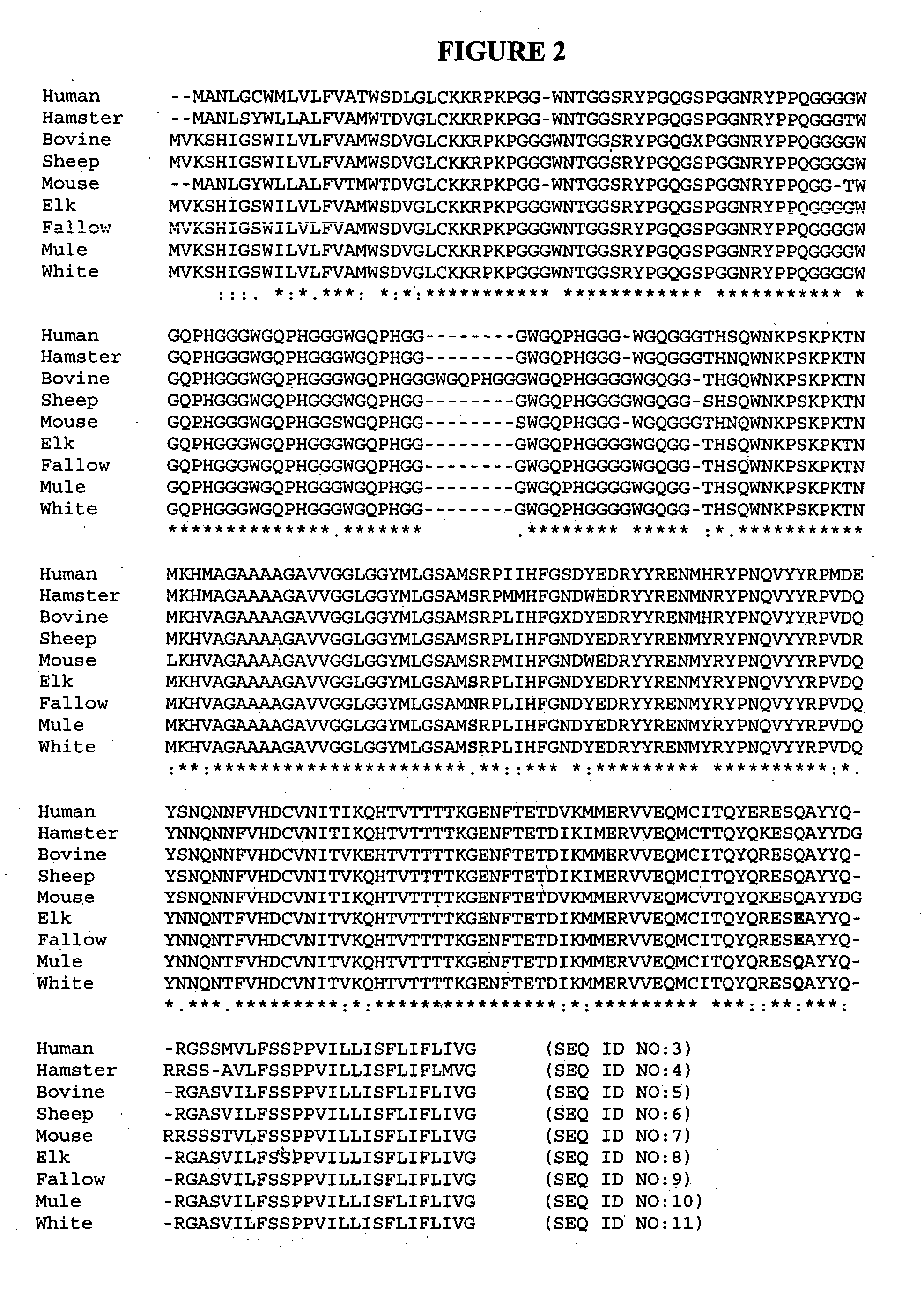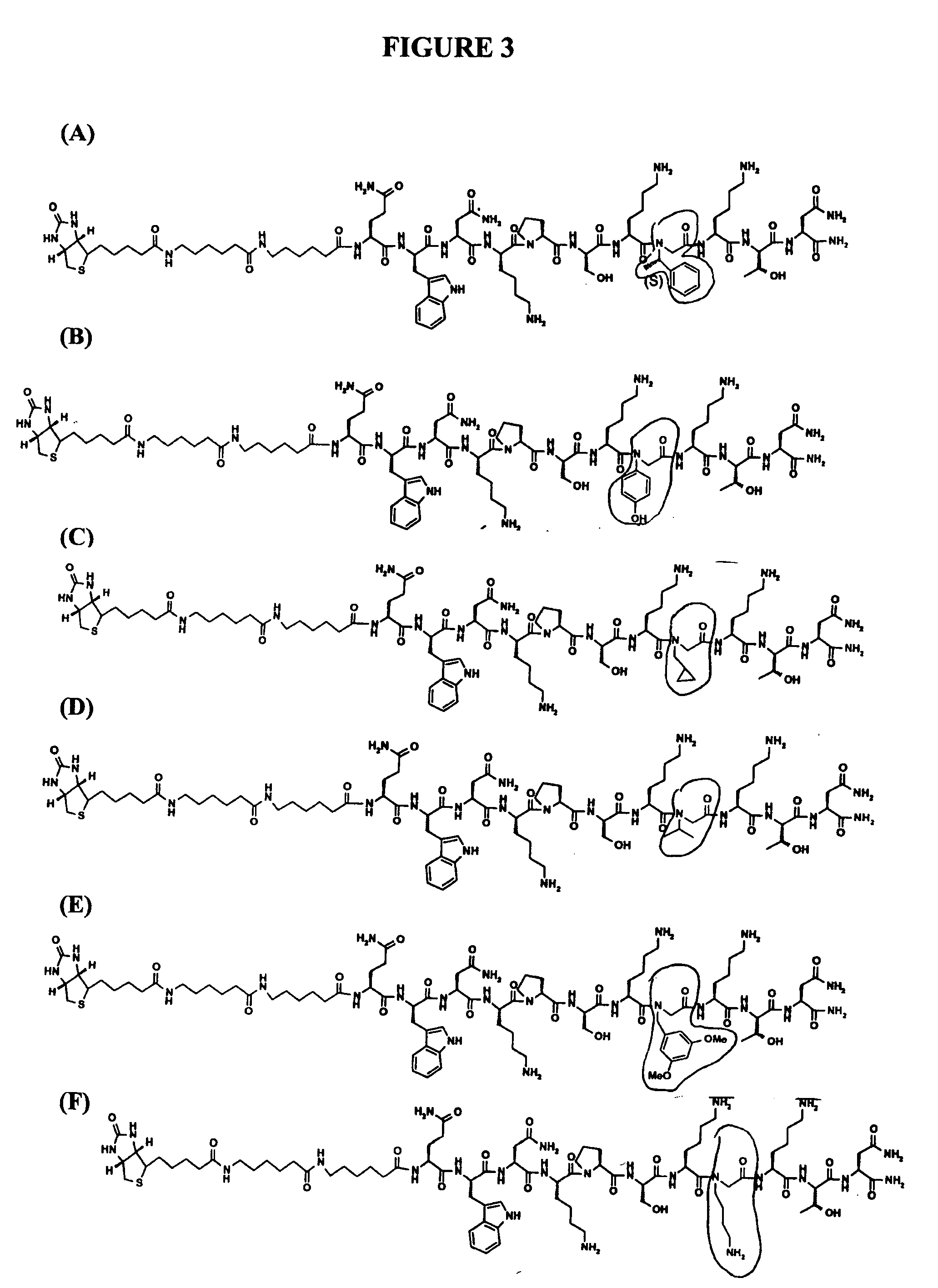Prion-specific peptide reagents
a peptide and reagent technology, applied in the field of peptide reagents, can solve the problems of unmet definitive diagnosis and palliative treatment of amyloid-containing conditions before the subject's death, the risk of brain biopsies, and the inability to detect the pathogenic isoforms of conformational disease proteins in living subjects and samples obtained from living subjects
- Summary
- Abstract
- Description
- Claims
- Application Information
AI Technical Summary
Benefits of technology
Problems solved by technology
Method used
Image
Examples
example 1
[0314] Peptide fragments of prion proteins were chemically synthesized using standard peptide synthesis techniques, essentially as described in Merrifield (1969) Advan. Enzymol. 32: 221 and Holm and Medal (1989), Multiple column peptide synthesis, p. 208E, Bayer and G. Jung (ed.), Peptides 1988, Walter de Gruyter & Co. Berlin-N.Y. Peptides were purified by HPLC and sequence verified by mass spectroscopy.
[0315] In certain cases, the peptides synthesized included additional residues at the N or C terminus, for example GGG residues and / or included one or more amino acid substitutions as compared to wild-type sequences.
A. Peptoid Substitutions
[0316] Peptoid substitutions were also made in the peptide presented in SEQ ID NO:14 (QWNKPSKPKTN, corresponding to residues 97 to 107 of SEQ ID NO:2), SEQ ID NO:67 (KKRPKPGGWNTGG, corresponding to residues 23-36 of SEQ ID NO:2) and SEQ ID NO:68 (KKRPKPGG, corresponding to residues 23-30 of SEQ ID NO:2). In particular...
example 2
Binding Assays
A. Pull-Down
[0321] Peptide reagents as described herein were tested for their ability to specifically bind to prion proteins using a magnetic bead pull down assay. For this assay, the peptide reagents were labeled with biotin, which allowed attachment to streptavidin coated magnetic beads.
[0322] Brain homogenates are prepared from RML PrPSc+ and PrPC+Balb-c mice. In brief, 5 mL of TBS buffer (50 mM Tris-HCl pH 7.5 and 37.5mM NaCl) with 1% TW20 and 1% triton 100 was added to brains weighing 0.5 g to produce a 10% homogenate. The brain slurry was dounced until large particles had disappeared. Aliquots of 200 μl were diluted 1:1 in buffer were added to pre-cooled eppendorf tubes and the samples sonicated for several repeats of several seconds each. Samples were centrifuged for 10-15 minutes at 500× and the supernatants removed.
[0323] To test the effect of Proteinase K digestion, certain supernatants were divided into two samples and 4 μl of Proteinase K was added to ...
example 3
Antibody Production
[0334] The following provides an example of a protocol that can be used to generate antibodies to the peptide reagents of the invention.
[0335] Mice are immunized with a composition comprising a peptide reagent as described herein (e.g., any one of SEQ ID NOs:12-108, preferably any one of SEQ ID NOs:14, 35, 50, 51, 56, 57, 65, 66, 67, 68, 72, 73, 77, 81, 82) either IM (intramuscular) or IP (intraperitoneal) on day 0, followed by 2-5 boosts at intervals of not more frequently than every 2 weeks. Blood is collected before the first immunization and then 7 days following each boost to monitor the humoral response to the antigen. 6 orbital eye bleeds are taken from each animal (three from each eye) of approximately 0.2 mls or less per bleed. The final boost is delivered by IV (intravenous) injection. Three days after the final boost, mice are euthanized by exposure to CO2 or isofluorane followed by cervical dislocation. Spleens are then harvested for hybridoma produc...
PUM
| Property | Measurement | Unit |
|---|---|---|
| Responsivity | aaaaa | aaaaa |
| Immunogenicity | aaaaa | aaaaa |
Abstract
Description
Claims
Application Information
 Login to View More
Login to View More - R&D
- Intellectual Property
- Life Sciences
- Materials
- Tech Scout
- Unparalleled Data Quality
- Higher Quality Content
- 60% Fewer Hallucinations
Browse by: Latest US Patents, China's latest patents, Technical Efficacy Thesaurus, Application Domain, Technology Topic, Popular Technical Reports.
© 2025 PatSnap. All rights reserved.Legal|Privacy policy|Modern Slavery Act Transparency Statement|Sitemap|About US| Contact US: help@patsnap.com



